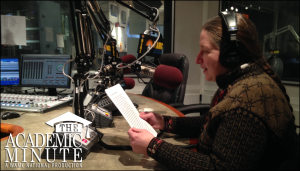Heidi Newberg, RPI – The Size of the Galaxy
This universe of ours is pretty big, and it might be bigger than we think.
Heidi Newberg, astronomer and physicist at Rensselaer Polytechnic Institute, is studying the size of the galaxy.
Dr. Heidi Newberg has worked in many areas of astronomy over the course of her career. She did her Ph.D. with the Berkeley Automated Supernova Search, which measured the supernova rates as a function of supernova type in Virgo-distance galaxies; and the Supernova Cosmology Project (SCP), which is measured the cosmological parameters Omega and Lambda using the light curves of distant supernovae. She shared the Gruber Cosmology Prize for her work with SCP.
 She helped to build the Sloan Digital Sky Survey (SDSS), which imaged ~10,000 square degrees of the sky in five optical filters, and obtained over a million spectra of galaxies. She initiated the Sloan Extension for Galactic Understanding and Exploration (SEGUE) project in SDSS II, which obtained spectra for 250,000 Galactic stars.
She helped to build the Sloan Digital Sky Survey (SDSS), which imaged ~10,000 square degrees of the sky in five optical filters, and obtained over a million spectra of galaxies. She initiated the Sloan Extension for Galactic Understanding and Exploration (SEGUE) project in SDSS II, which obtained spectra for 250,000 Galactic stars.
She has published papers in diverse areas of galactic and extragalactic astronomy, including: supernova phenomenology, measuring cosmological parameters from supernovae, galaxy photometry, color selection of QSOs, properties of stars, astronomy education, and the structure of our galaxy.
Newberg was elected a Fellow of the American Physical Society “For her contributions to our understanding of the structure of the Milky Way galaxy and the Universe, and for the development of software and hardware infrastructure for measuring and extracting meaningful information from large astronomical survey data sets.”
The Size of the Galaxy
![]()
Fifteen years ago I discovered what looked like a ring of stars around the Milky Way.
The stellar disk; which is shaped kind of like a Frisbee and is where one finds the Sun, the spiral arms, and most of our galaxy’s light; was supposed to be smaller than the ring.
It looked like there was a disk of stars, and then a gap, and then a ringlike feature.
I thought the ring of stars must have formed when a small galaxy traveled too close to the Milky Way, and the gravity from our galaxy ripped the stars from it.
The slightly faster stars ran out ahead and the slower ones trailed behind so that the small galaxy was transformed into a long stream of stars in orbit around us. At the time we were finding many star streams in the outer part of the Galaxy that looked just like this. But then, no one could figure out how the stars would end up in a circle.
And there was the coincidence that the ring lined up with the disk.
This made some think the ring was part of that disk, even though it didn’t match any of the models. But now, I too think the stars are part of the disk.
That is because I found that the stars in the disk are not in a flattened plane; the disk is corrugated like cardboard or metal roofing; it wiggles up and down and up and down in a series of ringlike features around the galaxy center.
The stars wiggled up into our line of sight and then down out of our view and then up again making it look like there was a ring. Those wiggles might be caused by a small dwarf galaxy that passed through our galaxy’s disk of stars, making waves like a pebble in a pond.
So I guess the ring wasn’t the remains of a small galaxy, it was just the small galaxy signaling to us that it was there.
Read More: RPI News: The Corrugated Galaxy—Milky Way May Be Much Larger Than Previously Estimated




